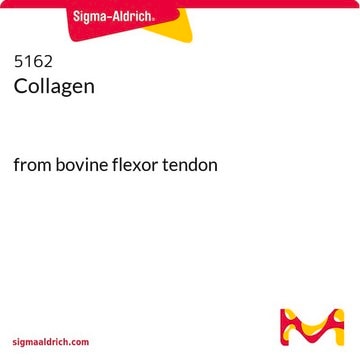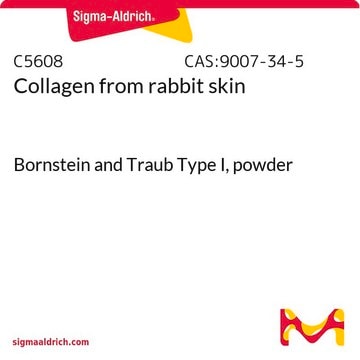11179179001
Roche
Collagen
from rat tail tendon
Synonyme(s) :
collagen
About This Item
Produits recommandés
Source biologique
rat tail
Niveau de qualité
Stérilité
sterile
Forme
lyophilized (clear, colorless solution after reconstitution)
Conditionnement
pkg of 30 mg
Fabricant/nom de marque
Roche
Technique(s)
cell culture | mammalian: suitable
Numéro d'accès UniProt
Température de stockage
2-8°C
Informations sur le gène
rat ... Col1a1(29393)
Catégories apparentées
Description générale
Spécificité
Application
Actions biochimiques/physiologiques
Caractéristiques et avantages
Lyophilizate, cell culture grade, 3 vials of 10mg
Caractéristiques
Notes préparatoires
5 μg/cm2 for the coating of cell culture vessels; for the preparation of collagen gels, a final concentration of 2 to 3 mg/ml is used.
Reconstitution
For the preparation of collagen gels, the content of the bottle should be dissolved in 3.3 ml sterile 0.2% acetic acid (v/v) each. This results in a final concentration of 3 mg/ml.
For coating culture dishes the final concentration should be 1 to 2 mg/ml.
Note: For dissolving: do not stir, just pour the acetic acid onto the lyophilizate and allow it to stand for several hours until it has dissolved. To completely dissolve the product an incubation for up to a maximum of 24 hours at 15 to 25 °C may be required.
Reconstitution of the Collagen should be done at 15 to 25 °C, higher temperatures destroy the fibres and may prevent the subsequent gelation of the Collagen.
Autres remarques
Code de la classe de stockage
11 - Combustible Solids
Classe de danger pour l'eau (WGK)
WGK 1
Point d'éclair (°F)
does not flash
Point d'éclair (°C)
does not flash
Certificats d'analyse (COA)
Recherchez un Certificats d'analyse (COA) en saisissant le numéro de lot du produit. Les numéros de lot figurent sur l'étiquette du produit après les mots "Lot" ou "Batch".
Déjà en possession de ce produit ?
Retrouvez la documentation relative aux produits que vous avez récemment achetés dans la Bibliothèque de documents.
Les clients ont également consulté
Articles
The extracellular matrix (ECM) is secreted by cells and surrounds them in tissues.
3D cell culture overview. Learn about 2D vs 3D cell culture, advantages of 3D cell culture, and techniques available to develop 3D cell models
Notre équipe de scientifiques dispose d'une expérience dans tous les secteurs de la recherche, notamment en sciences de la vie, science des matériaux, synthèse chimique, chromatographie, analyse et dans de nombreux autres domaines..
Contacter notre Service technique










